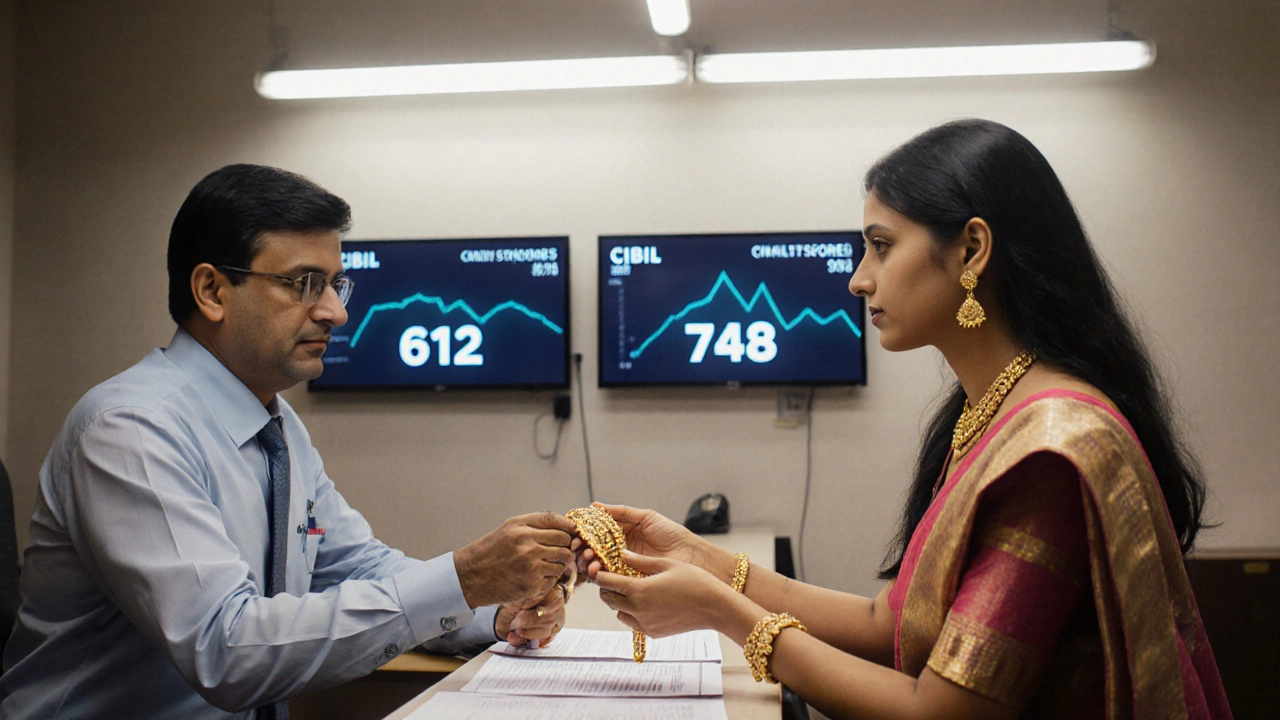There’s a big difference between knowing a gold loan interest rate and actually understanding what it means for your wallet. Most people just see a number on a signboard at the bank or a website. But that number decides how much you’ll actually pay back after pawning your gold. In India, these rates can range wildly—sometimes from 7% to over 20% per year.
The rate you get isn’t just about luck. It’s set by the lender after checking things like your repayment history, the type and purity of gold, and even the loan amount. Some banks might look more generous than others, but small details can change the final cost a lot faster than most folks realize. If you’re comparing offers, don’t just focus on the flashy numbers—look for the fine print about processing fees or extra charges.
- How Gold Loan Interest Rates Work
- Factors That Affect Your Gold Loan Rate
- Fixed vs Floating Gold Loan Rates
- Comparing Interest Rates Across Lenders
- Tips to Get a Lower Gold Loan Rate
- Hidden Charges and How to Avoid Surprises
How Gold Loan Interest Rates Work
When you walk into a bank or NBFC for a gold loan, the interest rate is basically what you’ll pay the lender for borrowing money against your gold. It’s usually quoted as a yearly percentage, and it can make a huge impact on your repayment amount. In India, these loans are super popular because they’re hassle-free and usually get approved fast, as lenders see gold as a solid guarantee.
The gold loan interest rate you’ll get often depends on the type of institution you choose. For example, public sector banks tend to offer lower rates than most private banks and NBFCs. But here’s what’s interesting: every lender uses their own way to figure out how risky you are as a borrower and how much your gold is worth. That’s why you’ll see rates all over the place—from 7.0% up to 24% per year, based on the latest available numbers from early 2025.
The lender checks the purity and the overall value of the gold you’re pledging. Then, based on the "Loan-to-Value" (LTV) ratio, you can usually borrow up to 75% of that value. But banks sometimes tweak this based on RBI rules or their own policies. The main thing to know: higher LTVs or riskier customers often mean higher interest “to play it safe.”
Here’s how gold loan interest rates usually get set up:
- Type of lender (public bank, private bank, NBFC, co-op society)
- The amount you want to borrow
- Loan tenure (tenure under a year is common, but up to 3 years is possible)
- Your credit history, especially if you’ve taken gold loans before
Monthly payments (EMIs) mostly depend on whether your rate is fixed or floating. Usually, gold loans come with monthly, quarterly, or even bullet (one-shot) repayment options.
| Lender Type | Typical Interest Rate (per annum) |
|---|---|
| Public Banks | 7% - 11% |
| Private Banks | 9% - 16% |
| NBFCs | 12% - 24% |
If you pay back early, some lenders may give you a discount on interest. But don’t miss payments, or your interest can pile up super quick. When you’re looking at offers, don’t just check the main rate—ask about processing fees, valuation fees, and late payment charges.
Factors That Affect Your Gold Loan Rate
If you’ve ever wondered why your friend got a gold loan at 9% and you’re looking at 14%, you’re not alone. It’s not random—banks and NBFCs (non-banking financial companies) have clear cut-offs and reasons for those differences. Let’s break down what actually pushes your gold loan interest rate up or down.
- Purity and value of gold: Lenders only accept gold between 18 to 24 karats. Higher purity means a higher loan amount and sometimes better rates since the lender feels safer.
- Loan amount: Taking a big gold loan can sometimes help you get a lower interest rate. Borrowing less can mean higher rates because the lender wants to make the small amounts worth their while.
- Lender type: Public sector banks usually offer lower rates compared to private banks or NBFCs. If you’re willing to stick with paperwork and wait times, you might save money.
- Relationship with lender: Already got an account or a history with the lender? They might give you a special rate—think loyalty discounts or hidden perks.
- Repayment plan: Regular EMI plans or interest-only options impact rate offers. Flexible plans might cost more.
- Market trends: RBI often tweaks lending rates. When repo rates go up, most gold loan rates creep up too, and vice versa.
Spotting the right deal is more than just looking for low numbers. The table below shows average gold loan rates as of 2025 for different kinds of lenders in India. This should give you a ballpark idea of what’s normal.
| Lender Type | Average Gold Loan Interest Rate (per annum) |
|---|---|
| Public Sector Bank | 8.5% - 11% |
| Private Bank | 10% - 15% |
| NBFC | 12% - 24% |
Never forget to ask about extra charges like processing fees, foreclosure penalties, and valuation fees. Even if the rate looks nice, these extras can add up fast. Always do the maths, and don’t hesitate to negotiate, especially if you’ve got a solid repayment record or a high-purity gold stash.
Fixed vs Floating Gold Loan Rates
If you’ve checked with different lenders, you might’ve heard the terms "fixed" and "floating" being thrown around. They sound complicated, but here’s what’s actually going on with these gold loan interest rate types.
Gold loan interest rate is "fixed" when it doesn’t budge for the whole term of your loan. You lock in one rate, and that’s what you pay every month. Most Indian banks and NBFCs (non-banking financial companies) offer fixed rates for gold loans, usually to keep things simple for both sides. Right now, fixed rates go from about 8% to 18% per year, depending on your lender, your gold, and the loan amount.
On the other hand, a "floating" rate will go up or down during your repayment period. It changes whenever the lender’s base lending rate or market rate changes—kind of like how petrol prices seem to shift every week. Floating rates may start lower but can rise suddenly, so you could end up paying more than you planned if the market shifts.
| Type | How It Works | Typical Range (May 2025, India) | Risk/Reward |
|---|---|---|---|
| Fixed | Doesn’t change, set at the start. | 8% - 18% per year | Predictable, no nasty surprises. |
| Floating | Changes with market rates. | 7.5% - 17% per year (can rise or fall) | Can save money if rates drop, but risky if they shoot up. |
So, which should you go for? If you know you’ll need predictable payments and don’t like surprises, a fixed rate keeps things easy. But if you love chasing bargains and think rates might drop soon, a floating rate could save you money—just watch out for sudden jumps. Many people in India still pick fixed rates, just because it’s one less thing to worry about.
- Most gold loans under Rs.5 lakh are given at fixed rates.
- Floating rates are more common for bigger loans or with certain private lenders.
- Always ask what happens if the lender’s base rate changes by more than 1%—it matters.
Bottom line: read the loan agreement and ask direct questions about how your interest can change. One half-hour of asking saves a lot of headaches later.

Comparing Interest Rates Across Lenders
Shopping around before settling on a gold loan lender is seriously worth it. Even a 1% difference in the gold loan interest rate can add up to thousands of extra rupees if you’re taking a bigger loan or need more time to repay. Don’t just walk into the bank where you have a savings account—many times, non-banking finance companies (NBFCs) or even digital loan apps offer better deals for the same amount of gold.
Let’s look at real numbers. As of May 2025, these are the typical rates from popular banks and NBFCs in India:
| Lender | Interest Rate (per annum) | Processing Fee |
|---|---|---|
| State Bank of India (SBI) | 7.5% – 8.55% | Up to 0.5% of loan amount |
| HDFC Bank | 9.50% – 14.5% | Up to 1% of loan amount |
| Muthoot Finance | 8.50% – 22% | Flat ₹20 – ₹500 |
| Manappuram Finance | 12% – 26% | Flat ₹10 – ₹1000 |
| ICICI Bank | 10% – 16.5% | Up to 1% of loan amount |
These figures show just how wild the range can be. NBFCs like Muthoot and Manappuram go higher on rates but can be more flexible on paperwork, while national banks tend to keep it tighter on both rates and charges.
When comparing, here’s what actually matters:
- Check the total interest you pay, not just the rate. Ask the lender to tell you the EMI or total repayment amount.
- Factor in processing and prepayment charges. Sometimes, a lower interest rate is wiped out by high one-time fees or penalties for early closure.
- Look for any add-ons like insurance or document charges that sneak onto the final bill. Always get a list of all charges in writing before you sign.
If you’re shortlisting, try to get a digital quote from at least three lenders. Many banks offer quick estimate tools on their website. Snap a photo of their offer or ask for it by email so you can refer back and not get confused by small print.
Get in the habit of comparing apples to apples. Is the offer for a fixed or floating rate? What’s the tenure? Sometimes rates are lower for shorter loans, but that means bigger EMI every month. Match the loan period and amount across lenders so you aren’t misled by what looks like a good deal on paper but isn’t practical for your cash flow.
Tips to Get a Lower Gold Loan Rate
Getting a better deal on your gold loan interest rate is possible if you know what to ask and where to look. Lenders don’t always advertise their lowest rates up front. Being smart at the counter can save you thousands of rupees over the life of your loan.
- Shop Around: Don’t just walk into the nearest bank or NBFC. Use comparison sites or ask at least three lenders about their rates and charges. Some co-op banks and small NBFCs offer deals that are much lower than big national banks.
- Keep Your Credit in Check: Believe it or not, some lenders check your CIBIL score before offering a gold loan. If you have a good score (750+), push for a rate cut. Lenders see you as less risky, so use that bargaining chip.
- Loan-to-Value (LTV) Ratio: If you take a smaller loan compared to the value of your gold, some banks reward you with a lower interest rate. For example, if your gold is worth ₹2 lakh but you only need ₹1 lakh, mention this upfront.
- Negotiate Fees: Processing fees, renewal charges, and valuation fees can add up. Sometimes you can get them waived or lowered by asking, especially if you have an account with that bank or bring in new customers.
- Choose the Right Tenure: Shorter loan tenures often come with lower rates. Opt for a three to six-month period if you can pay it off quickly. Don’t take a 12-month loan just out of habit.
Here’s a quick look at how much the rate can change based on lender type and loan details:
| Lender Type | Interest Rate (p.a.) | Processing Fees |
|---|---|---|
| Public Sector Bank | 8.0% – 12.5% | ₹500 – ₹1,500 |
| Private Bank | 9.0% – 16.0% | Up to 2% of loan |
| NBFC | 12.0% – 24.0% | Flat ₹200 – ₹1,200 |
| Co-operative Bank | 7.5% – 13.0% | ₹200 – ₹800 |
Before you say yes to any offer, double-check the actual amount you will have to pay back every month. Some places charge interest monthly, some quarterly—this affects your cost more than you’d expect.
Also, ask if you’ll get extra services, like SMS alerts for EMIs or better rates if you repay early. A little conversation can go a long way in saving money on your next gold loan.
Hidden Charges and How to Avoid Surprises
Getting a gold loan in India can look simple, but if you’re not careful, the bill at the end may sting. Most lenders advertise the gold loan interest rate upfront, but rarely talk about the extra charges that pile up. These can quietly eat into whatever cash you’ve borrowed and mess up your entire repayment plan.
Let’s get specific. Here’s a table showing the common hidden fees you might run into with a gold loan:
| Type of Charge | Typical Range (₹) | When It's Charged |
|---|---|---|
| Processing Fee | 0.5% – 2% of loan amount | Upfront, during loan sanction |
| Valuation Fee | ₹200 – ₹1,000 | When the gold is evaluated |
| Foreclosure Charges | 0% – 2% of loan amount | If you close loan early |
| Late Payment Penalty | Up to 3% per month on overdue amount | For missed payments |
| Renewal or Extension Charges | ₹200 – ₹1,000 | When extending the loan |
Now, how do you avoid these surprises? Here are a few practical pointers:
- Ask for a break-up sheet. Don’t just take the lender’s word for it—ask for every detail in writing before you hand over your gold.
- Read the loan agreement. Boring? Totally. But it’s where the lender tucks in those extra charges that can catch you off guard.
- Compare offers, not just rates. The lowest interest rate can be a trap if the fees are sky-high. Put everything on a sheet and see what’s actually cheapest in the end.
- Clarify foreclosure rules. If you plan to repay early (maybe you win the lottery, or just save up sooner), check if they’ll penalize you for closing before time.
- Set payment reminders. Even banks with friendly faces will slap you with penalties the moment you miss a due date—no exceptions.
One smart move? Always ask if negotiations are possible, especially for the big charges like processing or valuation fees. It doesn’t work every time, but sometimes just asking gets you a better deal. And remember, as soon as you spot something odd or unclear, don’t hesitate to question your lender. Your gold deserves that extra bit of caution.



